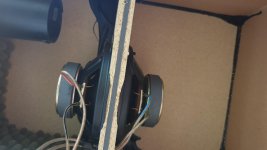I was seeking a bit more bass on my sub. So i opened it up to see the crossover circuit.
I am still learning tearing old speakers apart but never a sub. So my question might seem dumb but here it goes. How or why is it a good idea to place the speakers like that ? Does it not reduce the effect ?
Its a jamo subwoofer.
All the best
Jess
I am still learning tearing old speakers apart but never a sub. So my question might seem dumb but here it goes. How or why is it a good idea to place the speakers like that ? Does it not reduce the effect ?
Its a jamo subwoofer.
All the best
Jess
Attachments
The search term you're looking for is "isobaric". It has its uses. Not my favourite way of doing things, though.
Chris
Chris
Last edited:
I think Jamo uses this technique because it results in the equivalent of a dual voice coil woofer. Two coils are required when a single subwoofer must be connected to a stereo amplifier.
You´ll notice, that the drivers are connected in opposite phase, so the membranes are moving the same way.... not opposite each other 🙂
It is an isobarik with the space minimized via the space between the cones. It also looks like it is a bandpass.
One should end up with half the required box volume.
Using 2 to take advantage of a stereo amp is a good point as well.
dave
One should end up with half the required box volume.
Using 2 to take advantage of a stereo amp is a good point as well.
dave
If you simply start from scratch with the isobaric TS parameters instead of looking at it as a Vas / 2, the results tend to be a lot more constructive then if comparing it as an apple to 1 or 2 Sd of that driver. MLTL can be really neat with this. If you already have the parts, it’s kinda silly to pursue it though?? I’ve only done it with ‘leftovers’ from car audio and made an Mltl that was rear vented on the other side with a restrictor plate to fine tune the response (in theory, ��)..
- Home
- Loudspeakers
- Subwoofers
- How is this a good idea ?
